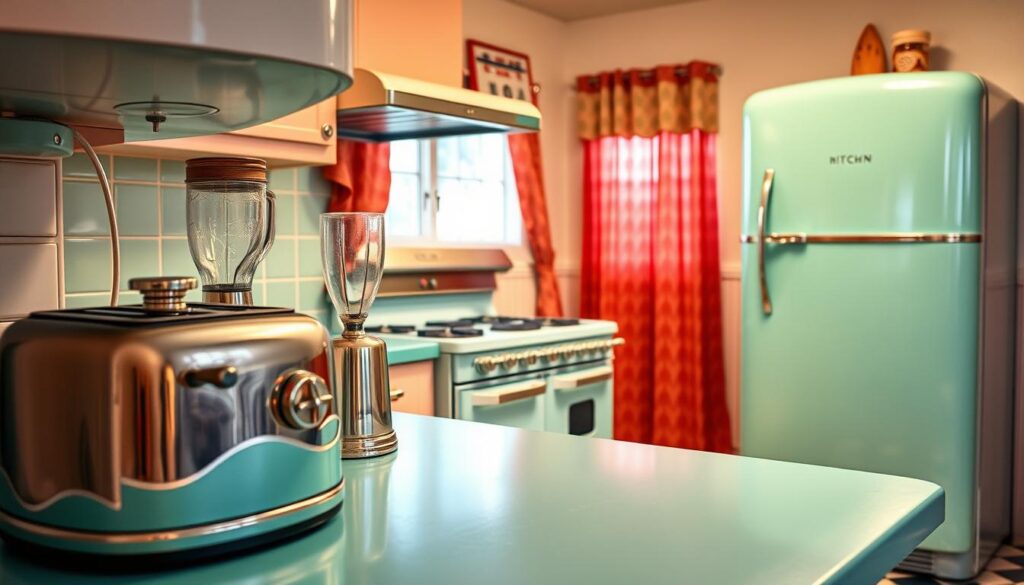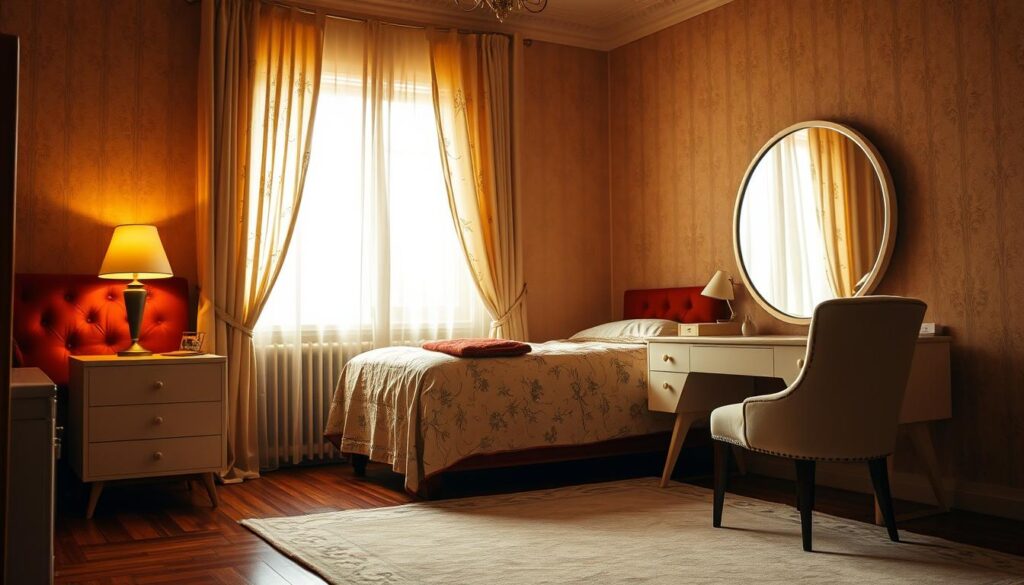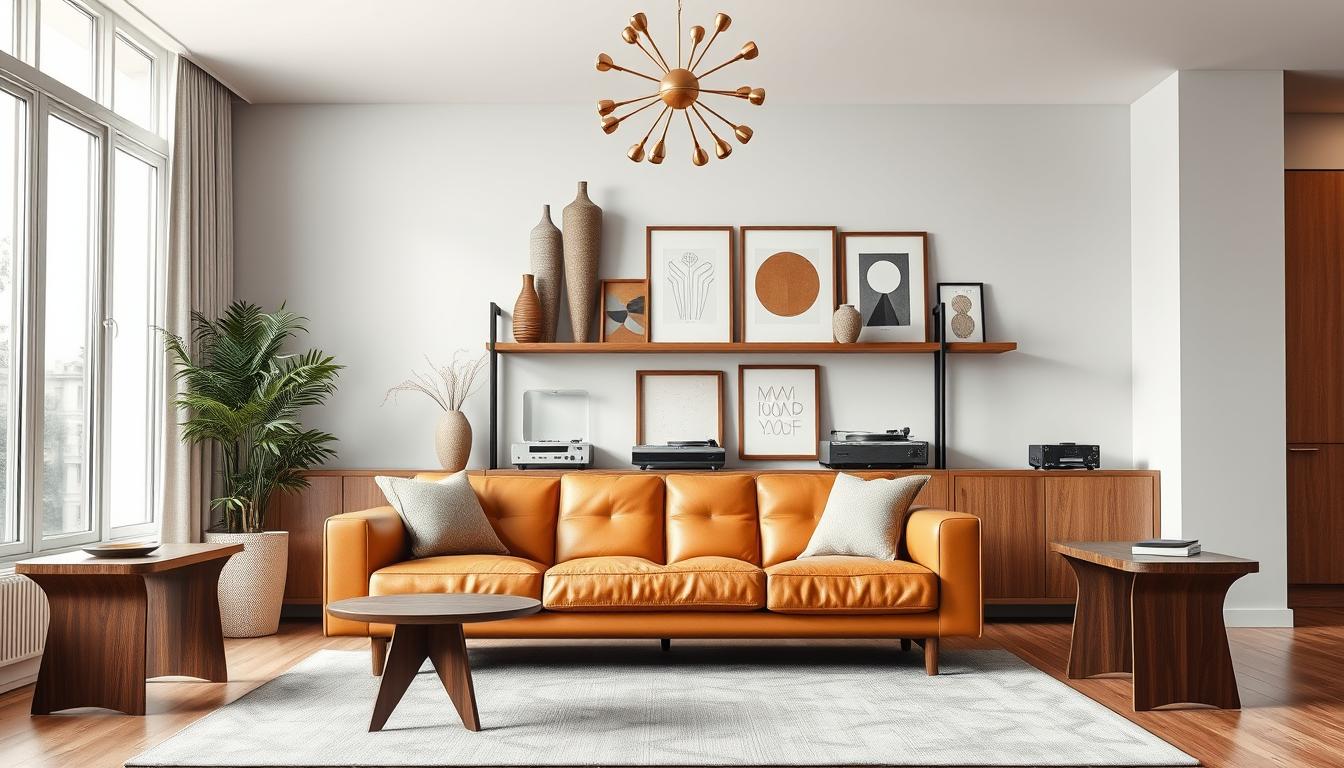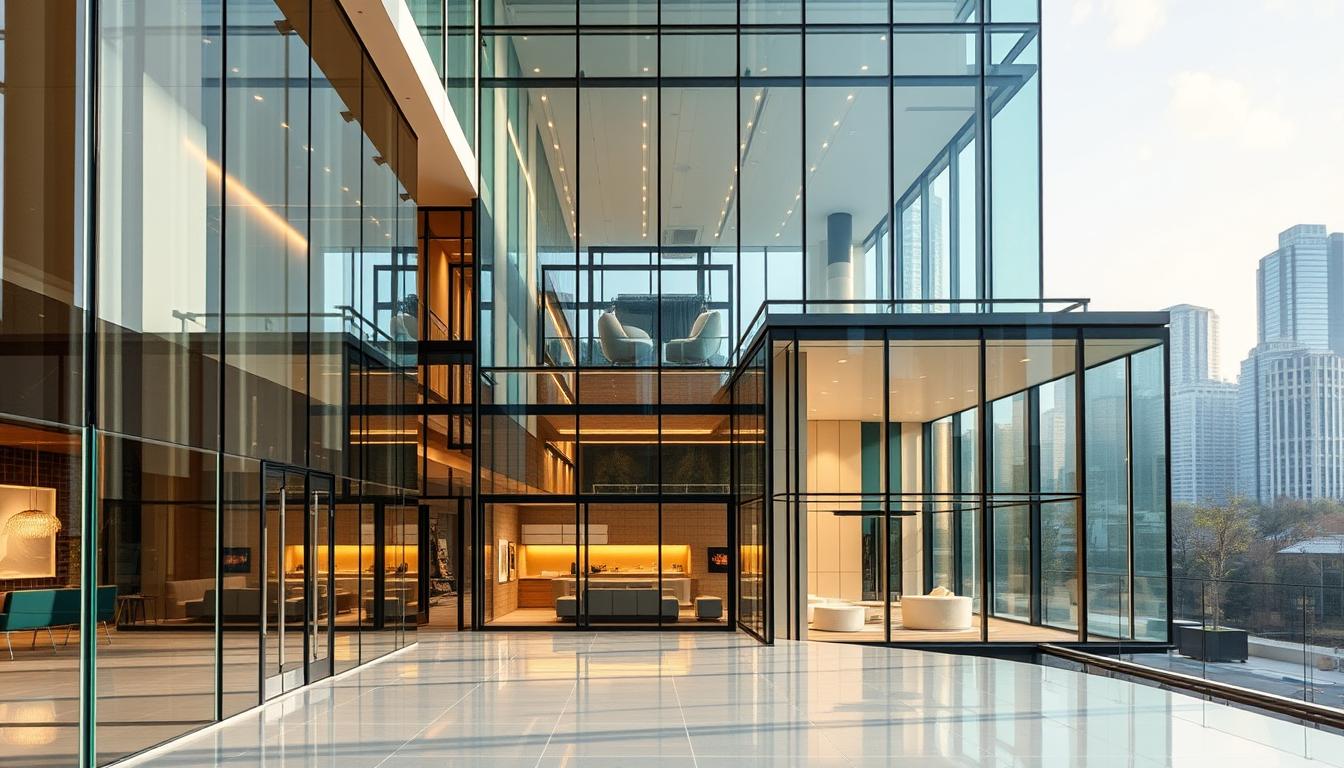The 1950s was a decade of big change in retro home decor. It was marked by the rise of consumer culture and post-war optimism. This led to bold colors, funky patterns, and iconic furniture pieces. These elements still excite design enthusiasts today.
We’ll dive into the key elements of a 1950s-inspired look. You’ll learn how to add these touches to your home. We’ll show you how to embrace the mid-century modern design that’s now a key part of modern decor.
Key Takeaways
- Understand the core elements of 1950s-inspired decor
- Learn how to incorporate bold colors and patterns into your space
- Discover iconic furniture pieces that define the era’s style
- Get practical tips on styling a retro-inspired home
- Explore the influence of mid-century modern design on contemporary decor
Understanding the 1950s Home Aesthetic
To create a 1950s-inspired home, it’s key to know the decade’s design principles. The 1950s saw big changes in home design, thanks to cultural and economic shifts after the war.
Key Characteristics of 1950s Design
The 1950s design focused on being functional, colorful, and using new materials and tech. Some main traits include:
- Functionality: Furniture and decor were made to be practical, showing the era’s focus on efficiency.
- Bold Colors: The 1950s loved vibrant, bold colors in design, making homes playful.
- New Materials: New tech brought materials like plastics and aluminum into decor, used in creative ways.
Popular Color Palettes
The 1950s had unique color palettes that defined the era’s look. Popular colors were:
- Pastel Shades: Soft pastels were used in kitchens, bathrooms, and bedrooms for a calming feel.
- Bold Primaries: Bright primary colors were used in statement pieces or accent walls for a pop of color.
- Earth Tones: Earthy tones like olive green and harvest gold were popular in furniture and appliances, adding warmth.
Iconic Furniture Styles
Furniture in the 1950s had iconic styles that are still loved today. Some top styles include:
- Mid-Century Modern: Known for clean lines, organic shapes, and focus on function, mid-century modern furniture is still popular.
- Retro-Inspired Pieces: Furniture with a retro vibe, like egg-shaped chairs and boomerang-patterned textiles, brought whimsy to 1950s homes.
By knowing these elements, homeowners can bring the 1950s home aesthetic into their homes. This captures the essence of this iconic era.
Essential Elements of 1950s Decor
To make a 1950s-inspired home, knowing the key elements is crucial. The 1950s saw big changes in interior design. New materials, technologies, and styles emerged.
Mid-Century Modern Furniture
Mid-Century Modern furniture is a hallmark of 1950s decor. It’s known for clean lines, organic shapes, and practical design. Pieces like the Eames Lounge Chair and the Noguchi Coffee Table are now modern decor staples.
Unique Lighting Fixtures
1950s lighting is famous for its sculptural shapes and innovative designs. Sputnik chandeliers, with their futuristic look, are iconic. Table lamps with abstract shapes also add retro glamour.
Accessories and Decor
Accessories and decor are key to the 1950s look. Vintage posters, retro textiles, and decorative items like vintage vases and figurines are essential. They help create a cohesive, stylish space that honors the era.
By using Mid-Century Modern furniture, unique lighting, and period-specific accessories, we can bring the charm of a 1950s home to life.
Choosing the Right Color Scheme
To capture the 1950s vibe in your home, pick colors that are playful and optimistic. The 1950s were known for bold and colorful designs. Choosing the right colors is key to your interior design.
Pastel Shades vs. Bold Colors
The 1950s loved pastel shades for kitchens and bathrooms. They created a soft, calming feel. But, bold colors were also big, adding energy to rooms.
Think about what look you want. Pastel shades like soft pink and baby blue are great for a subtle vibe. For something bolder, try red, turquoise, and yellow.
- Pastel Shades: Soft and calming, ideal for kitchens and bathrooms.
- Bold Colors: Energetic and statement-making, perfect for living areas and accent walls.
The Role of Patterns in 1950s Design
Patterns were big in 1950s design, adding interest to walls, furniture, and textiles. Geometric shapes and abstract motifs were favorites, making rooms lively and fun.
When using patterns, mix different sizes and textures for depth. For example, a bold wallpaper with a subtle rug adds layers to your design.
- Start with a dominant pattern, such as a bold geometric print.
- Balance the dominant pattern with secondary patterns, like subtle textures or smaller geometric motifs.
- Use solid colors to break up the patterns and prevent overwhelming the space.
By carefully choosing colors and patterns, you can make a 1950s-inspired home that’s both nostalgic and lively. Whether you prefer pastel shades or bold colors, the most important thing is to have fun and be creative.
Incorporating Retro Appliances
Retro appliances bring a nostalgic feel to modern kitchens. They are key to a 1950s-inspired home renovation. Adding these appliances makes your design more authentic.
Classic kitchen appliances were known for their unique styles. These designs have become iconic over time. Appliances like refrigerators and ovens were both functional and decorative.
Classic Kitchen Appliances
The 1950s were famous for pastel-colored appliances. These included refrigerators and stoves in soft colors like mint green and pale pink. These colors defined the era’s kitchen look.
- Pastel-colored refrigerators and stoves
- Bold, graphic designs on appliances
- Iconic brands that have stood the test of time
Brands like General Electric and Frigidaire were big in the 1950s. They were known for their innovative designs and functionality. Today, these brands inspire modern appliance makers, offering retro-style appliances that mix nostalgia with modern features.
Refrigerator and Oven Styles
1950s refrigerators and ovens were designed to stand out. Refrigerators had rounded edges and unique handles. Ovens and stoves had bold designs, like chrome accents and colorful finishes.

When picking retro appliances for your renovation, think about the look you want. Choose from pastel colors or bold designs. Either way, these appliances will add retro charm to your kitchen.
Using retro appliances in your decor creates a unique, nostalgic vibe. For a retro home decor that’s both true to the 1950s and stylish, mix these appliances with vintage furniture and classic colors.
Flooring Options for a 1950s Look
To get a true 1950s vibe, picking the right flooring is key. The 1950s favored many flooring types, each adding its own charm to homes.
Popular Flooring Materials
The 1950s homes mixed classic and modern floors. The top picks were:
- Hardwood flooring, loved for its lasting beauty
- Linoleum, a flexible and colorful choice
- Vinyl flooring, prized for being affordable and easy to clean
These floors were used in creative ways. They often featured bold colors and patterns to make rooms pop.
| Material | Characteristics | Design Options |
|---|---|---|
| Hardwood | Durable, timeless | Various wood types, stains |
| Linoleum | Versatile, practical | Range of patterns, colors |
| Vinyl | Affordable, easy maintenance | Multiple designs, patterns |
Tips for Achieving Authenticity
To make your flooring truly 1950s, follow these tips:
- Choose materials and patterns from the era
- Match the colors to 1950s design
- Think about your overall design and pick flooring that fits
With the right flooring, you can make your home look like it’s straight from the 1950s. It will feel welcoming and true to its historical roots.
Designing a 1950s Kitchen
A 1950s-inspired kitchen brings back the era’s style, with retro appliances and bold colors. It’s important to mix old charm with today’s needs.
Layout and Functionality
1950s kitchens were designed to be functional, with a closed-off layout. They had lots of cabinets and counter space. A central island or peninsula added extra counter space and sometimes seating.
- Use a combination of upper and lower cabinets to maximize storage.
- Incorporate a kitchen island or peninsula for extra counter space and potential seating.
- Choose a layout that promotes workflow efficiency, such as the classic “work triangle” between sink, stove, and refrigerator.
Must-Have Features
Key features of a 1950s kitchen include retro appliances, bold colors, and graphic patterns. Appliances from Smeg and Big Chill add style and function.
- Retro-style appliances in bold colors or classic finishes like chrome.
- Bold, graphic patterns on wallpaper, flooring, or accessories.
- Iconic lighting fixtures, such as sputnik chandeliers or globe pendant lights.
“The kitchen is the heart of the home, and in the 1950s, it was a space that truly reflected the era’s optimism and focus on family.”
| Material | Characteristics | Authenticity |
|---|---|---|
| Formica | Durable, affordable, variety of patterns | High |
| Granite | Luxurious, durable, natural beauty | Low |
| Laminate | Budget-friendly, versatile, easy to install | Medium |
By adding these elements, you can make a 1950s kitchen that’s both nostalgic and useful.
Living Room Inspirations
In the 1950s, living rooms were all about bold statement pieces. We’ll look at what makes a 1950s living room so special. You’ll see how to bring that era’s charm into your home.
Statement Furnishings
Mid-century modern design is key for a 1950s living room. A sleek sofa or a retro armchair can be the room’s star. Look for furniture with clean lines and organic shapes that’s also functional.
Some must-haves for statement furnishings are:
- Bold, geometric patterns
- Rich, vibrant colors
- Unique textures, like walnut or teak wood
Decorative Accessories
Decorative accessories let you show off your style. Vintage interior trends suggest adding vintage posters, retro textiles, and sculptural objects. These add interest and personality to your space.
Here are some decorative accessories to consider:
| Accessory | Description | Era Inspiration |
|---|---|---|
| Vintage Posters | Colorful ads or travel posters | 1950s Advertising |
| Retro Textiles | Fabrics with geometric patterns or abstract designs | Mid-Century Modern |
| Sculptural Objects | Unique decorative pieces, like vases or sculptures | Abstract Art |
By mixing statement furnishings with the right accessories, you can make a 1950s-inspired living room. It will be stylish and welcoming.
Bedroom Designs from the 1950s
To bring 1950s design into your bedroom, focus on classic furniture and decor. The 1950s bedroom was a cozy, elegant space filled with nostalgia.

Furniture Choices
For a 1950s-style bedroom, choose iconic 1950s furniture styles like a vintage dresser or retro bedframe. These pieces add a nostalgic charm and make your space stylish and welcoming.
Look for furniture with clean lines and organic shapes. This is key to mid-century modern design.
Bedding and Linens
Bedding and linens are essential for a 1950s bedroom look. Go for vintage-inspired duvets and retro-style pillowcases to bring in 1950s glamour.
Choose patterns and colors from the 1950s, like pastels, bold geometrics, and classic florals. This will help you achieve a cohesive, authentic look.
By adding these touches, you’ll create a bedroom that honors the 1950s. It will also be a serene and stylish retreat.
Infusing Vintage Accessories
Adding vintage touches to your home can make it look amazing. Vintage accessories bring the charm of the 1950s into your space. They add a unique style that’s hard to find today.
Looking for real vintage items is key. You can find them in vintage shops, thrift stores, and online. Each piece, from posters to furniture, has its own story. They help create the perfect atmosphere in your home.
Authentic Pieces
Here’s what to keep in mind when searching for vintage accessories:
- Focus on items typical of the 1950s, like vintage kitchen gadgets and retro dinnerware.
- Check the condition of items. You might be able to fix or reuse them.
- Online and in stores, make sure items are genuine. Check their history and authenticity.
For more ideas on embracing the retro style, check out our guide on 1950s-inspired home interiors.
Repurposing Techniques
Turning old items into new ones is good for the planet and adds a personal touch. Here are some ideas:
| Original Item | Repurposed Use |
|---|---|
| Old suitcases | Storage units or coffee tables |
| Vintage windows | Room dividers or decorative wall hangings |
| Antique doors | Headboards or wall art |
Repurposing vintage items adds character and tells a story of creativity and sustainability.
By using vintage accessories and repurposing items, you can make your home truly special. Whether you love retro home decor or just want to add some vintage flair, these tips will help you get the look you want.
Bringing the Outside In
Bringing the outside in is key in historical interior design, focusing on 1950s homes. The 1950s brought a big change towards outdoor living. This was due to suburbanization and the rise of backyard fun. We can mix elements to make the indoors feel like outdoors.
Retro Landscaping Ideas
Landscaping was big in 1950s homes. They had neat lawns, bright flowers, and modern outdoor features. To get a retro vibe, think about adding:
- Geometric garden designs
- Vibrant floral patterns
- Manicured hedges and lawns
These will make your outdoor area look great and match your 1950s home.
Outdoor Furniture Styles of the 1950s
Outdoor furniture in the 1950s was all about sleek lines, strong materials, and comfort. To get this look, look into these styles:
| Furniture Style | Characteristics | Materials |
|---|---|---|
| Wrought-Iron Patio Sets | Elegant, curved lines | Wrought iron, cushions |
| Retro-Inspired Lounge Chairs | Bold colors, sleek designs | Metal, vinyl, fabric |
| Bamboo Furniture | Natural, organic look | Bamboo, rattan |
By using these landscaping and furniture ideas, we can make a smooth transition between inside and outside. This captures the 1950s design spirit.
Final Tips for a Cohesive Look
To make your home look great, mix old and new styles. Use vintage furniture and decor with modern pieces. This creates a unique and interesting look.
Blending Styles
Combine mid-century modern design with retro home decor accessories. This mix adds depth and interest to your space.
Adding Personal Touches
Make your home special with family photos, vintage collectibles, or retro artwork. These add to the retro feel and make your space welcoming.
Follow these tips to create a stylish and authentic 1950s-inspired home. It will showcase the beauty of retro and mid-century modern design.


